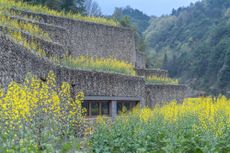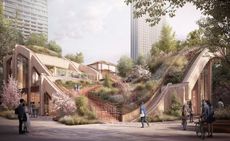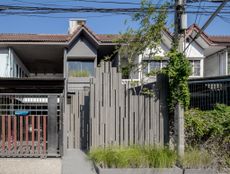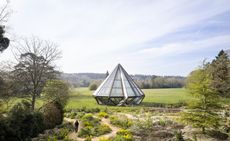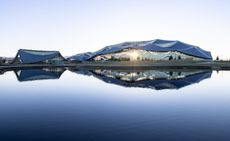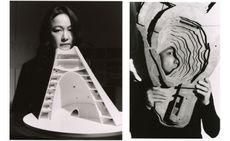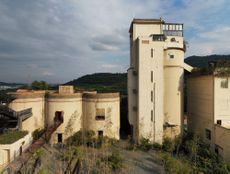Heatherwick Studio’s 1000 Trees blooms in Shanghai
Heatherwick Studio’s 1000 Trees is Shanghai’s newest mixed-use development, blending trees, art and sculptural concrete
- (opens in new tab)
- (opens in new tab)
- (opens in new tab)
- Sign up to our newsletter Newsletter
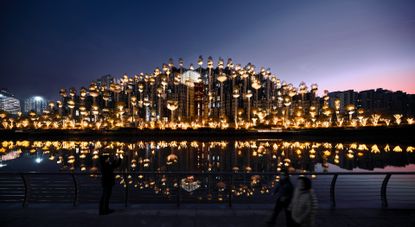
The first phase of Heatherwick Studio’s 1000 Trees has finally opened in Shanghai, unsurprisingly a couple of years behind schedule (thanks to the pandemic) but as verdant and striking as the name and early renders suggested. The mixed-use development takes up just part of a 15-acre site bounded to the north by Suzhou Creek and by the M50 art district to the south. From the river, the building is deliberately hard to read, a 60m tall, gently sloping, terraced jumble of horizontally striped stone and towering planters in unapologetically raw and rippled concrete.
For studio founder and head Thomas Heatherwick, 1000 Trees reimagines large-scale urban developments as open, social spaces rather than blank monolithic boxes or towers. ‘Many big buildings just feel cold, sterile and monotonous on the outside,’ he says, ‘so our challenge was to create something engaging on a human scale.’
1000 Trees: the first phase

Based around a 9m grid, the building twists 45 degrees to get maximum river views. The studio’s biggest idea, though, was leaving the development’s giant supporting columns on the outside and turning them into those planted podiums, exposed sections of cliff topped with trees, shrubs, grasses, flowers and climbers. The exoskeleton device allows for more open and lighter space inside but also means, says Heatherwick, that shops, restaurants, galleries, even a kindergarten all have outdoor terraces. The building is also deliberately porous, and accessible from multiple angles with walkways at various levels. Heatherwick likens it to a termite mound.
‘We felt an enormous responsibility to make sure that commerce not be its only atmosphere and to make a community heart,’ he says, ‘that it has a diversity of places to explore and is somewhere that people can just be.’ (The design was, of course, plotted long before the Covid-19 pandemic – Heatherwick nods to the influence of Jan Gehl, the Danish architect, urbanist and author of Life Between Buildings and Public Spaces, Public Life – but that provision of outdoor space now looks beyond prescient.)

1000 Trees, though, has also become a lightning rod for a lively debate in the architectural press about the positives and not-so-positives of ‘urban greening’. Those for verdant buildings argue that their plants and trees increase biodiversity, lower temperatures, suck in CO2 and other pollutants, reduce noise and generally lift the spirits. Critics argue that those benefits are far outweighed by the carbon output of building in concrete and steel, and that maintaining green walls and roofs is resource intensive, though living walls are far more at fault here. Heatherwick Studio says the planting on 1000 Trees is all local, will change with the seasons and has been carefully researched and picked to minimise pruning and maintenance.
RELATED STORY

Heatherwick Studio’s 1000 Trees project takes root in Shanghai (opens in new tab)
Heatherwick and Lisa Finlay, the studio’s group lead on the 1000 Trees project, say another key priority was engaging with the low-level reused warehouses and industrial buildings of the M50 art district on the other side of the development. ‘The planning regulations clearly expected us to build a huge tower on a podium, but that would have made a mockery of the art district,’ says Heatherwick. ‘The most respectful thing we could do was to come to meet it at street level and at its scale, to blur that boundary as much as we could.’

The much less discussed south-facing façade, then, is essentially an angled display space for local art especially commissioned for the building by French street artist and M50 champion Paul Dezio. Local artists have also been invited to create 40m-high murals inside the building’s elevator shafts, visible from glass cars. Heatherwick says the artwork is ‘an acknowledgement that no one designer should be allowed to do projects this big. They need to be diverse. Single brains will create something that is too much of one thing.’
An external glass lift, meanwhile, is housed in a tower of weathered Cor-ten steel blades, a shimmery echo and reimagining (and repositioning) of part of a flour mill that once stood on the site. ‘The city said they wanted to remember that there was a mill there and asked us to rebuild its tower,’ explains Heatherwick. ‘Initially, everyone said “No, we can’t do that. It’s kitsch, it’s ridiculous.” But then we thought, this is an enormous project, the more idiosyncrasy the better, so how do we keep this memory but make it useful?’

For Heatherwick, the steel tower exemplifies the studio’s mission to build the strange and unexpected into its large-scale developments. ‘I deeply believe in not copying the past but I'm really proud of the tower. We're really interested in how we build, in what typically gets eradicated, and not creating sterile dead places. Everyone loves clean lines but clean lines are actually boring. So how do you get dirty lines?’ The entire 1000 Trees plot is bisected by a road, and phase two of the development, another forested urban mountain but this one 100m tall, is now under construction. The new development, which has to work its way around four existing heritage buildings, will include workspace, a cinema, a hotel, as well as a large park and an amphitheatre.
Finlay says the team will now be studying how people use phase one of the development, alert to the fact that the pandemic has permanently shifted behaviour and needs in dense urban areas. ‘We want to do a lot of monitoring over the next year,’ says Finlay, ‘and look at how the terraces and spaces are actually being used. It might be used in completely different ways to what we imagined, so let’s find out.’

INFORMATION
heatherwick.com (opens in new tab)
-
 Remembering New York artist Daniel Brush, 1947 – 2022
Remembering New York artist Daniel Brush, 1947 – 2022In tribute to Daniel Brush, who has died aged 75, we revisit this 2020 Wallpaper* profile of the elusive New York artist by jewellery historian Vivienne Becker, who unravelled the secrets of his singular designs for her book, ‘Daniel Brush: Jewels Sculpture’
By Vivienne Becker • Published
-
 Interior design books championing shelf love
Interior design books championing shelf loveWelcome to the Wallpaper* guide of the best interior design books published in 2022 and beyond – a collection of riveting visual tomes to feed creative innovation, inspiration and imagination
By Rosa Bertoli • Published
-
 Christmas decorations from leading creatives and design brands
Christmas decorations from leading creatives and design brandsOur edit of contemporary Christmas decorations ranges from architect-designed festive ornaments to Christmas baubles by leading creatives
By Rosa Bertoli • Published
-
 China’s Qingxi Culture and History Museum draws on its surrounding land
China’s Qingxi Culture and History Museum draws on its surrounding landQingxi Culture and History Museum by UAD is a cultural destination in China designed in harmony with its surroundings
By Ellie Stathaki • Last updated
-
 Heatherwick Studio unveils undulating mixed-use Tokyo scheme design
Heatherwick Studio unveils undulating mixed-use Tokyo scheme designBy Ellie Stathaki • Last updated
-
 HAS Design + Research, Thailand and China: Wallpaper* Architects’ Directory 2022
HAS Design + Research, Thailand and China: Wallpaper* Architects’ Directory 2022Wallpaper* Architects’ Directory is our annual round-up of exciting emerging architecture studios. Next up, is Thailand- and China-based HAS Design + Research
By Ellie Stathaki • Last updated
-
 A multi-functional event space by Wutopia Lab celebrates daily life in the city
A multi-functional event space by Wutopia Lab celebrates daily life in the cityA Living Theatre Mount by Wutopia Lab is an exhibition, meeting and event space for developer Xuzhou Vanke in China's Jiangsu province
By Ellie Stathaki • Last updated
-
 Heatherwick Studio’s glasshouse architecture flowers in the English countryside
Heatherwick Studio’s glasshouse architecture flowers in the English countrysideHeatherwick Studio’s new glasshouse is a floral haven in West Sussex's Woolbeding Gardens
By Nick Compton • Last updated
-
 Google Bay View Campus by BIG and Heatherwick Studio reimagines workspace
Google Bay View Campus by BIG and Heatherwick Studio reimagines workspaceGoogle has worked with architects BIG and Heatherwick Studio on the new Bay View Campus in Silicon Valley
By Hannah Silver • Last updated
-
 Open architecture on building and China’s cultural landscape
Open architecture on building and China’s cultural landscapeOpen Architecture’s perfectly considered projects either disappear into the landscape or become new landmarks
By Yoko Choy • Last updated
-
 A Chinese industrial building transformation makes for a minimalist live/work space
A Chinese industrial building transformation makes for a minimalist live/work spaceThe renovation of an abandoned cement factory on the southeastern coast of China by designer Wanmu Shazi resulted in a minimalist and calming live/work space
By Ellie Stathaki • Last updated



